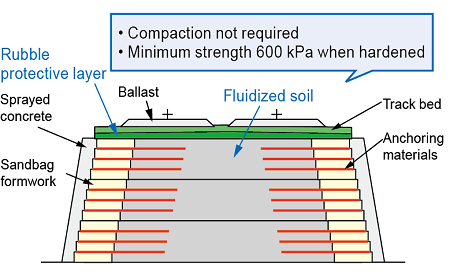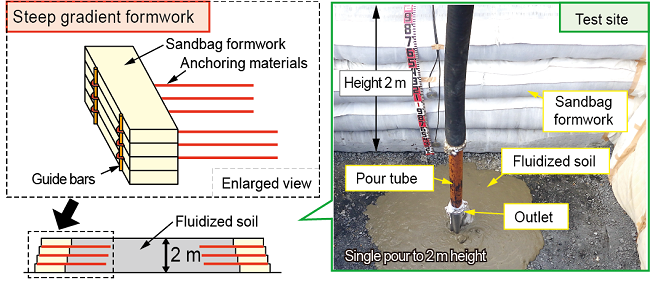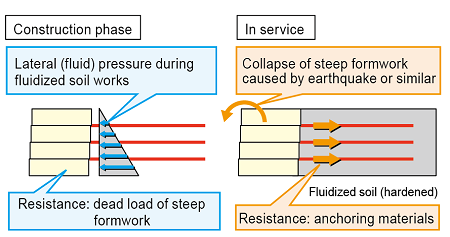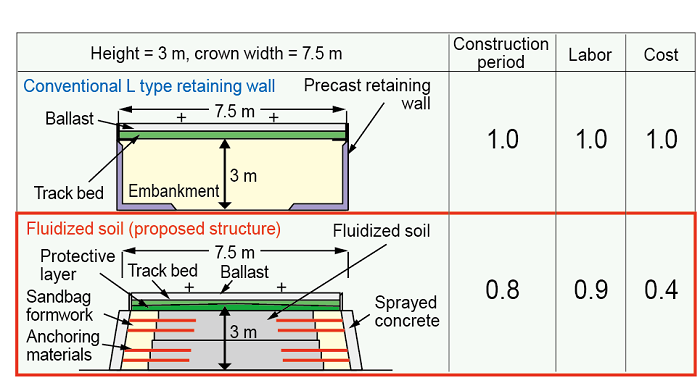15. Fast-track embankment structure for confined settings
Major projects such as track doubling in urban settings frequently involve construction of embankments in confined spaces, using small-scale construction machinery as well as compaction by hand. This is both time-consuming and labor-intensive, and a better solution is needed. Our solution uses fluidized soil, which is made by mixing cement and water into soil from construction works. Fluidized soil has excellent fluidity characteristics suitable for earthwork and does not require compaction, in contrast to conventional embankment construction. To date, fluidized soil has not been used in train embankments due to a lack of data on stability performance when subjected to train loads, and also because it has less strength when dry.
Our proposal adds a protective layer of rubble over the surface to prevent the fluidized soil from drying out (see Figure 1).
Taking into account dispersion of train load by the rubble layer, we have demonstrated the performance requirements of the fluidized soil including minimum required strength of 600 kPa. Fluidized soil offers good fluidity during the construction phase and good strength when hardened.
Our proposed embankment structure for confined settings uses a combination of sandbag formwork and anchoring materials, as shown in Figure 2.
This provides sufficient stability both during construction and once in service, as shown in Figure 3.
The construction phase is shorter than for conventional embankments, and the design allows for steeper slope gradients, thereby reducing the space required to accommodate the embankment.
Railway embankments in confined settings are traditionally made with precast retaining walls or similar.
We have shown that for an embankment of height 3 m and crown width 7.5 m, our proposed structure can be constructed 20% quicker and using 10% less labor (see Table 1).
Other Contents
- 9. Integrated analytics platform for railways
- 10. On-board obstacle detection system suitable for low-light conditions
- 11. Tool for estimating bridge deflection from on-board track irregularity measurements
- 12. Wear measuring apparatus for overhead conductor rail using light sectioning
- 13. Imaging analysis method for detecting various anomalies in overhead contact lines
- 14. Automated crew scheduling system
- 15. Fast-track embankment structure for confined settings
- 16. Numerical analysis method for predicting interaction impacts on closely adjacent tunnels
- 17. Method for evaluating girder vibration characteristics with consideration for track rigidity
- 18. Concrete repair methodology based on crack width and location
- 19. Using expansive concrete in track slabs to minimize reinforcement
- 20. Using temperature sensors to help predict service life of electronic signallingequipment
- 21. Effective and efficient steam weeding technique
- 9. Integrated analytics platform for railways
- 10. On-board obstacle detection system suitable for low-light conditions
- 11. Tool for estimating bridge deflection from on-board track irregularity measurements
- 12. Wear measuring apparatus for overhead conductor rail using light sectioning
- 13. Imaging analysis method for detecting various anomalies in overhead contact lines
- 14. Automated crew scheduling system
- 15. Fast-track embankment structure for confined settings
- 16. Numerical analysis method for predicting interaction impacts on closely adjacent tunnels
- 17. Method for evaluating girder vibration characteristics with consideration for track rigidity
- 18. Concrete repair methodology based on crack width and location
- 19. Using expansive concrete in track slabs to minimize reinforcement
- 20. Using temperature sensors to help predict service life of electronic signallingequipment
- 21. Effective and efficient steam weeding technique




